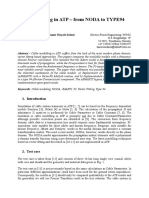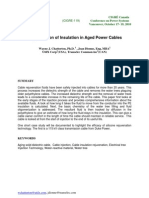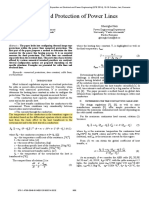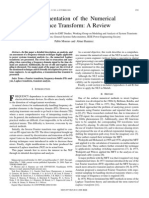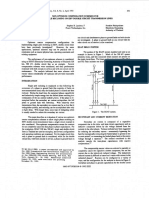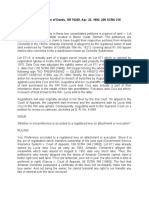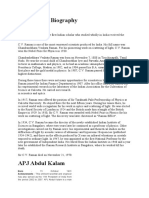Finite Element Analysis on Post Type Silicon Rubber Insulator Using MATLAB | ISSN: 2321-9939
IJEDRCP1402005
INTERNATIONAL JOURNAL OF ENGINEERING DEVELOPMENT AND RESEARCH | IJEDR(www.ijedr.org) (Two Day National Conference (RTEECE-2014) -17th ,18th January 2014)
23
Finite Element Analysis on Post Type Silicon Rubber Insulator Using MATLAB
1
Vishal Kahar,
2
Ch.v.sivakumar,
3
Dr.Basavaraja.B
Department of Electrical Engineering
1,2
Parul Institute of Engineering &Technology, Vadodara, Gujarat, India.
3
GITAM University, Hyderabad. Andhra Pradesh, India.
Abstract:
This paper presents the analysis of potential and electric distribution characteristics of outdoor polymer insulator. Silicone rubber provides an alternative to porcelain and glass regarding to high voltage (HV) insulators and it has
been widely used by power utilities since 1980’s owing to their
superior contaminant performances. Failure of outdoor high voltage (HV) insulator often involves the solid air interface insulation. As result, knowledge of the field distribution around high voltage (HV) insulators is very important to determine the electric field stress occurring on the insulator surface, particularly on the air side of the interface. Thus, concerning to this matter, this project would analyze the electric field distribution of energized silicone rubber high voltage (HV) insulator. And the simulation results of electric field and potential distributions along surface of silicone rubber polymer insulators under clean and contamination conditions. For comparative purposes, the analysis is based on two conditions, which are silicon rubber insulators with clean surfaces and silicon rubber insulators with effect of water droplets on the insulator surface. Finite element method (FEM) is adopted for this work. The electric field distribution computation is accomplished using MAT LAB-PDE TOOL software that performs two dimensions finite element method. The objective of this work is to comparison of both the alternative shed and straight shed type insulators under the effect of contamination on potential and electric field distributions along the insulator surface when water droplets exist on the insulator surface
Key Words:
Silicon rubber Insulator, Finite Element method, Electricfielddistribution, Potential distribution.
I.
INTRODUCTION
Silicon rubber composite insulators, which are now extensively accepted, did not come out until 1970s, and Germany is the first country developing and using this kind of insulator. Compared to conventional porcelain and glass insulators, composite insulators such as silicon rubber insulator offer more advantages in its application. For further information, this chapter would mainly discussed issue that related to silicon rubber insulator. The experience of outdoor insulator goes back to the introduction of telegraphic lines, in the 19
th
century. Service experience and product development with high voltage insulators made from glass and porcelain materials have been gathered over more than hundreds years. Porcelain and glass insulators completely dominated the market until the introduction of polymeric alternatives. The first polymeric insulator (epoxy) was made in United State of America in 1959, but it suffered from severe tracking and erosion. Similarly, for high voltage insulators, during the first three quarters of the 20th
century, the only material of choice for an outdoor high voltage insulator was porcelain. Natural occurring resins and gums that were available within the early part of the 20
th
century were shellac. Later, in 1907, rubber is created by Dr Baekland synthetic phenol formaldehyde. These two early polymer materials had good indoor properties, but being organic, with a carbon backbone in its chain, had a very poor track resistance. Later, during 1930s and 1940s, newer synthetic resins were developed and some of the earliest polymer insulators were made of butyl and acrylic materials. However, while they enjoy some commercial success, they quickly become obsolete because of high cost, limited manufacturing, versatility and most importantly, inadequate performance for high voltage application in outdoor environments
The development and application of cycloaliphatic epoxy helped to address the resin deficiency but did not able to address the coefficient of thermal expansion problem at the fiberglass rod or housing interface. Compounding materials to correct this compatibility problem resulted in depolymerization of the molded sheds in warm, humid environments which led to electromechanical failure Structure of a polymer insulator is shown in Fig. 1. The basic design of a polymer insulator is as follows; fiber reinforced plastic (FRP) core, attached with two metal fittings, is used as the load bearing structure. The presence of dirt and moisture in combination with electrical stress results in the occurrence of local discharges causing the material deterioration such as tracking and erosion. In order to protect the FRP core from various environmental stresses, such as ultraviolet, acid, ozone etc., and to provide a leakage distance With in a limited insulator length under contaminated and wet conditions, weather sheds are installed outside the FRP core. Silicone rubber is mainly used for polymer insulators or composite insulators as housing material.
Fig.1 Structure of a polymer insulator
The early development of modern polymeric insulators can be illustrated by the work of the German manufacturer Rosenthal, later called Hoechst Ceram Tec. Their development started in 1964 and prototypes for field installation were offered in 1967. However, it took until middle of the 1970s before a number of manufacturer offered commercial products of the first
Finite Element Analysis on Post Type Silicon Rubber Insulator Using MATLAB | ISSN: 2321-9939
IJEDRCP1402005
INTERNATIONAL JOURNAL OF ENGINEERING DEVELOPMENT AND RESEARCH | IJEDR(www.ijedr.org) (Two Day National Conference (RTEECE-2014) -17th ,18th January 2014)
24 generation polymeric transmission line insulator [6] as given in Table .1 First generation commercial polymeric transmission line insulator
TABLE -1
POLYMERIC TRANSMISSION LINE INSULATOR
* Ethylene propylene rubber * Silicon rubber * Cycloaliphatic epoxy
II.
DIMENSIONS OF DIFFERENT TYPES OF INSULATORS:
a) Straight shed b) Alternate shed
Fig.2.Basic Model Insulator
III.
PROBLEM SOLUTION EQUATION
A. Electric field and potential distributions calculation
One simple way for electric field calculation is to calculate electric potential distribution. Then, electric field distribution is directly obtained by minus gradient of electric potential distribution. In electrostatic field problem, electric field distribution can be written as follows [1]:
V E
(1)
From Maxwell’s equation
/
E
(2)
Where
is resistivity
m
/
,
ε
is material dielectric constant
)(
0
r
and
0
is free space dielectric constant (8.854
×
10
−
12
F/m)
r
is relative dielectric constant of dielectric material placing equation(1) into equation(2) Poisson equation is obtained.
)(
V
(3) Without space charge
=0,
poissions equation becomes Laplace equation
0)(
V
(4)
B. FEM analysis of the electric field distribution
:
The finite element method is one of numerical analysis methods based on the variation approach and has been Widely used in electric and magnetic field analysis since the late 1970s. Supposing that the domain under consideration does not contain any space and surface charges, two-dimensional functional
F
(
u
) in the Cartesian system of coordinates can be formed as follows[2]:
dxdydydudxduu F
D y x
22
21
(5) Where
x
and
y
are
x
- and
y
-components of dielectric constant
in the Cartesian system of coordinates and u is the electric potential. In case of isotropic permittivity distribution
)(
y x
Equation (5) can be rewritten ass
dxdydydudxduu F
D y
22
21
(6) If the effect of dielectric loss on the electric field Distribution is considered, the complex functional
F
(
u
) should be taken into account as
dxdydydudxdutg j21 F(U)
D
220
.
(7) where
is angular frequency
0
is the permittivity of free
space (8.85
×
10
-12
F/m),
tg
is tangent of the dielectric loss
angle, and
u
is the complex potential
.
Inside each sub domain
e
D
a linear variation of the electric potential is assumed
.
y x y xu
eeee
321
),(
;
),.....3,2,1(
nee
(8) Where
),(
y xu
e
is the electric potential of any arbitrary point inside each sub-domain
D
e
,
α
e1
,
α
e2
and
α
e3
represent the computational coefficients for a triangle element
e
,
n
e
is the total number of triangle elements. The calculation of the electric potential at every knot in the total network composed of many triangle elements was carried out by minimizing the functional
F(u)
, that is,
npiuu F
ii
,...2,1;0
)(
(9) Where
np
stands for the total number of knots in the network then a compact matrix expression
}{}{
ji ji
T u s
np ji
....3,2,1,
(10)
COMPANY HOUSING MATERIAL YEAR COUNTRY Ceraver Ohio Brass Rosenthal Sediver TDL Lapp Reliable EPR* EPR SIR* EPR CE* EPR SIR 1975 1976 1976 1977 1977 1980 1983 France USA Germany USA England USA USA
Finite Element Analysis on Post Type Silicon Rubber Insulator Using MATLAB | ISSN: 2321-9939
IJEDRCP1402005
INTERNATIONAL JOURNAL OF ENGINEERING DEVELOPMENT AND RESEARCH | IJEDR(www.ijedr.org) (Two Day National Conference (RTEECE-2014) -17th ,18th January 2014)
25 Where
ji
s
the matrix of coefficients is,
}{
i
u
is the vector of unknown potentials at the knots and
}{
j
T
is the vector of free terms. After (10) is successfully formed, the unknown potentials can be accordingly solved.
IV.
IMPLEMENTATION OF FEM
There are several methods for solving partial differential
equation such as Laplace’s and Poisson equation. The most
widely used methods are Finite Difference Method (FDM), Finite Element Method (FEM), Boundary Element Method (BEM) and Charge Simulation Method (CSM). In contrast to other methods, the Finite Element Method (FEM) takes into accounts for the no homogeneity of the solution region. Also, the systematic generality of the methods makes it a versatile tool for a wide range of problems. The following topics in this chapter would describe briefly on the concept of Finite Element Method (FEM) Straight sheds polymer insulator was selected to simulate electric field and potential distributions in this study. The basic design of a polymer insulator is as follows; A fiber reinforced plastic (FRP) core having relative dielectric constant of 7.1, attached with two metal fittings, is used as the load bearing structure. Weather sheds made of HTV silicone rubber having relative dielectric constant of 4.3 are installed outside the FRP core. Surrounding of the insulator is air having relative dielectric constant 1.0. A 15 kV voltage source directly applies to the lower electrode while the upper electrode connected to ground. Two dimensions of the alternate sheds polymer insulators for FEM analysis are shown in Fig. 3 The most common form of approximation solution for the voltage within an element is polynomial approximation. PDE Tool in MATLAB issued for finite element discretization. The obtaining results are 1,653 nodes and 3,180 elements for
straight sheds type insulator and 2,086 nodes and 4,030 elements for alternate sheds type insulator, respectively. The obtaining results are shown in Fig.4
a) Straight sheds b) Alternated sheds
Fig 3. Two dimension of the two type polymer insulators for FEM analysis
The whole problem domains in Fig. 5 are fictitiously divided into small triangular areas called domain.Thepotentials, which were unknown throughout the problem domain, were approximated in each of these elements n terms of the potential in their vertices called
nodes
. Details of Finite Element discretization are found in [5]. The most common form of approximation solution for the voltage within an element is a polynomial approximation. PDE Tool in MATLAB is used for finite element discretization. The results of FEM discretization for clean and contamination conditions illustrate in Fig. 4
a)Straight sheds b) Alternated Sheds
Fig4. Finite element discretization results
V.
SIMULATION RESULTS AND DISCUSSIONS
In this study, clean and contamination conditions are simulated using FEM via PDE Tool in MATLAB. Potential Distribution results are shown in Fig. 5(c) and electric field distribution are shown in Fig. 5(d).Comparison of potential and electric field distribution along surface of the two type polymer insulators are shown in Fig.5 and Fig. 6, respectively. Although nonlinear potential distribution along leakage distance of the two type specimens, no significant different can be seen on the straight sheds specimen comparing with the alternate shed specimen, as shown in Fig. 9 In spite of clean condition, electric field distribution on the straight sheds specimen is slightly higher than the alternate sheds specimen as shown in Fig 9. Contamination condition is simulated by place 12 water droplets on the two type insulator surfaces as shown in Fig. 7a and Fig. 8a. The simulation results of electric field and potential distributions are illustrated in Fig. 7(c) and Fig.8(c), respectively. Comparison of potential and electric field distribution along surface of the two type polymer insulators are shown in Fig. 9. In case of contamination condition, although nonlinear potential distribution along leakage distance of the two type specimens, no significant different can be seen on the straight sheds specimen comparing with the alternate shed specimen, as shown in Fig.7. The Results on Electric field and potential distributions for a straight sheds insulator as shown in blow Figs.
Finite Element Analysis on Post Type Silicon Rubber Insulator Using MATLAB | ISSN: 2321-9939
IJEDRCP1402005
INTERNATIONAL JOURNAL OF ENGINEERING DEVELOPMENT AND RESEARCH | IJEDR(www.ijedr.org) (Two Day National Conference (RTEECE-2014) -17th ,18th January 2014)
26
Fig5. (a). Straight Sheds Insulator Fig5. (b). Finite element discretization results Fig5. (c) Potential distribution under clean condition Fig5. (d). Electric field distribution under clean condition
The Results on Electric field and potential distributions for a Alternate sheds insulator as shown in blow Figs.
Fig6. (a). Alternated sheds insulator Fig6. (b). Finite Element Discretization Fig6. (c). Potentital Distribution under clean Contamination



























